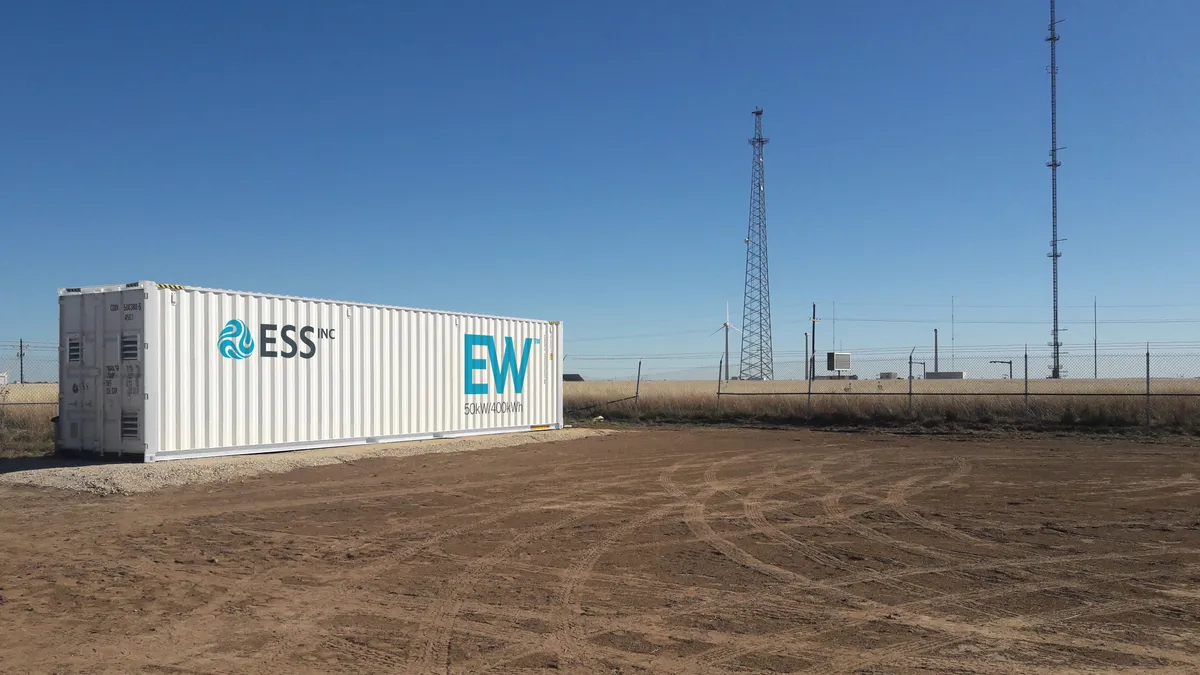Dive Brief:
- The long-duration energy storage market is on the verge of a major evolution that will help support a more rapid transition to renewable energy, speakers said at the Wood Mackenzie's Power & Renewables Conference on Tuesday and Wednesday.
- Eric Dresselhuys, CEO of flow battery company ESS Inc., said at the conference that the industry is "really on the cusp of maturity," pointing to the growth in new technologies and the changing attitudes of regulators in how to handle storage on the electricity market.
- "There's an incredible amount of change underway and we're just at the beginning of this process," said Emilie Nelson, executive vice president for the New York Independent System Operator (NYISO) on a separate panel. New rules for storage on the market, she added, will help send signals that will encourage developers to install new storage projects.
Dive Insight:
Long-duration storage is seen as a necessary tool as grid operators move to renewables, as it can store power for distribution at times when, say, the wind is not blowing or the sun is not out. However, the market has been held back by still emerging technology, regulatory uncertainty and the high cost of some storage tools.
Governments and technology companies have increasingly focused on making long-duration storage available and competitive with fossil fuel peaker plants. The Department of Energy announced in July an ambitious program to lower the cost of storage technology by 90% over the next decade. Several companies had advanced new technology, like a large-scale thermal storage project from Malta and Siemens and the announcement last week that Form Energy was working on a 100-hour iron-air exchange battery at a potential $20/kWh price point.
A Wood Mackenzie analysis found that 910 MWh of new energy storage were brought online in the first quarter of 2021, an increase of more than 252% over the first quarter of 2020. Wood Mackenzie energy analyst Vanessa Witte said at the conference that while Q1 of 2021 represented the third-largest quarter to date, it is likely to be the smallest of 2021, with some 200 GW of storage in interconnection queues across the country.
ESS CEO Dresselhuys said grid operators and developers are becoming more educated about the technology and economic opportunities of long-duration storage, especially how it can work alongside more prolific lithium-ion batteries that provide four hours of storage. "They're usually surprised to learn you can do all the things you do with a short-duration battery with a long-duration one," he said. Advancing the market, he said, will hinge on getting past the "either-or" attitude with batteries.
Dresselhuys' company, which went public this spring, produces flow batteries relying on iron, salt and water. The technology currently provides up to 12 hours of capacity, but ESS has debuted a large-scale solution that can support power providers and large manufacturers.
NYISO's Nelson, who heads the system planning, information technology and market structures operations, said the energy transition supported by storage technology is "achievable," especially with new offshore wind developments. However, it will depend on regulators and operators figuring out how to capture the unique benefits storage offers in a way that makes them competitive with natural gas plants. New York faces a particular challenge because the state's wind and solar opportunities are upstate, while the highest demand is concentrated downstate around New York City, requiring a large amount of long-duration storage around the city to handle the intermittency of renewables.
Order 841 from the Federal Energy Regulatory Commission has encouraged other system operators to revise rules around storage, which analysts expect to open more storage opportunities.
Justin Felt, manager of strategic planning for Baltimore Gas & Electric, said that as more long-duration storage is installed, operators will recognize even more opportunities beyond accelerating decarbonization. "This will open up some things on the distribution side," Felt said on a panel Wednesday.













